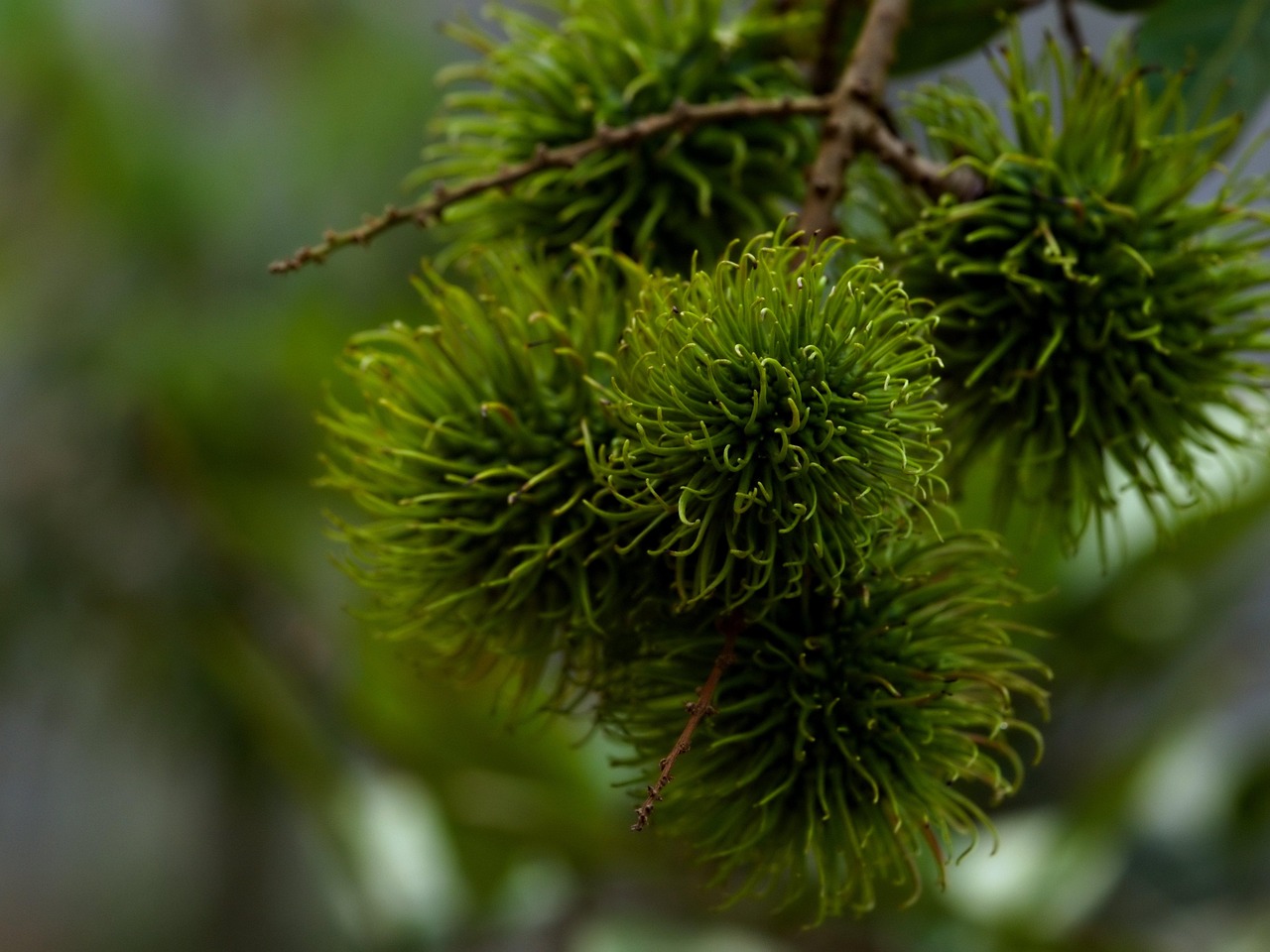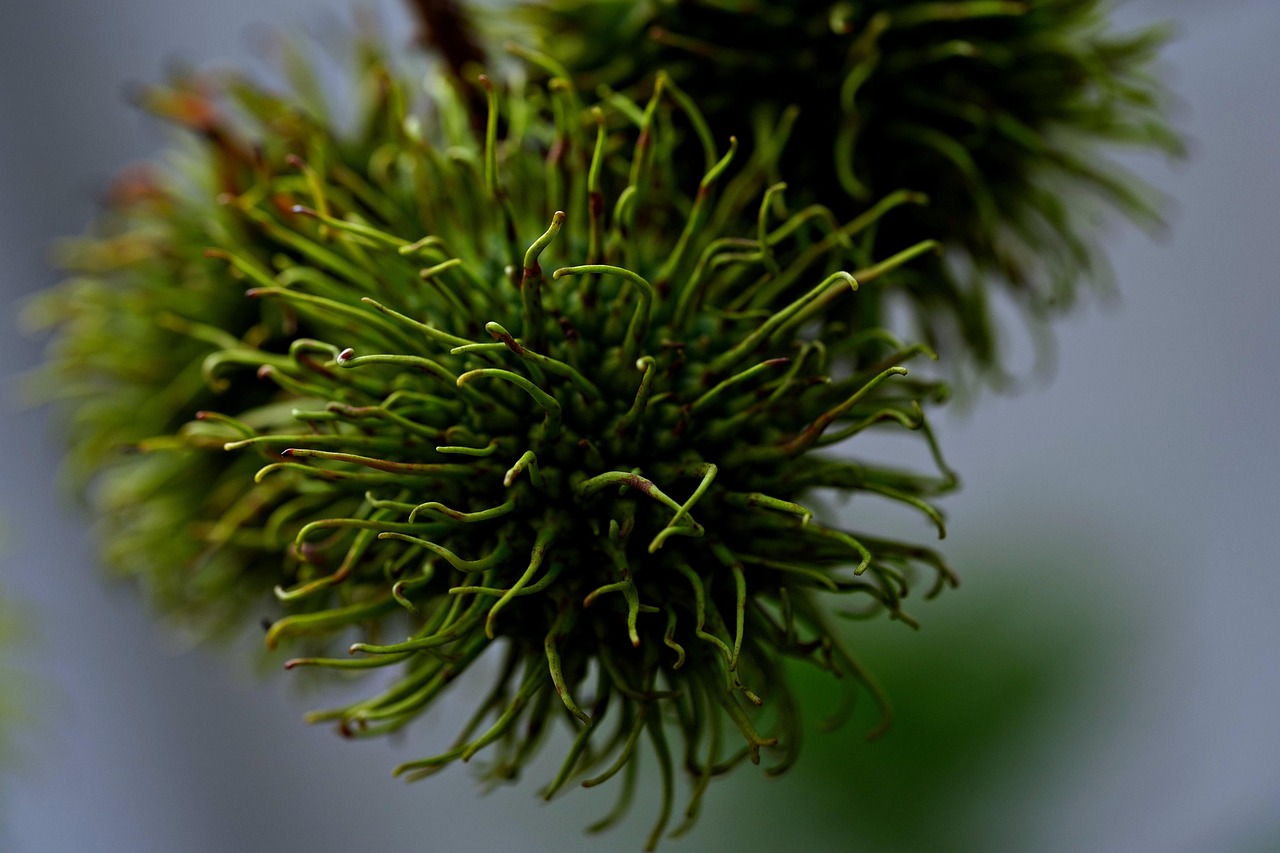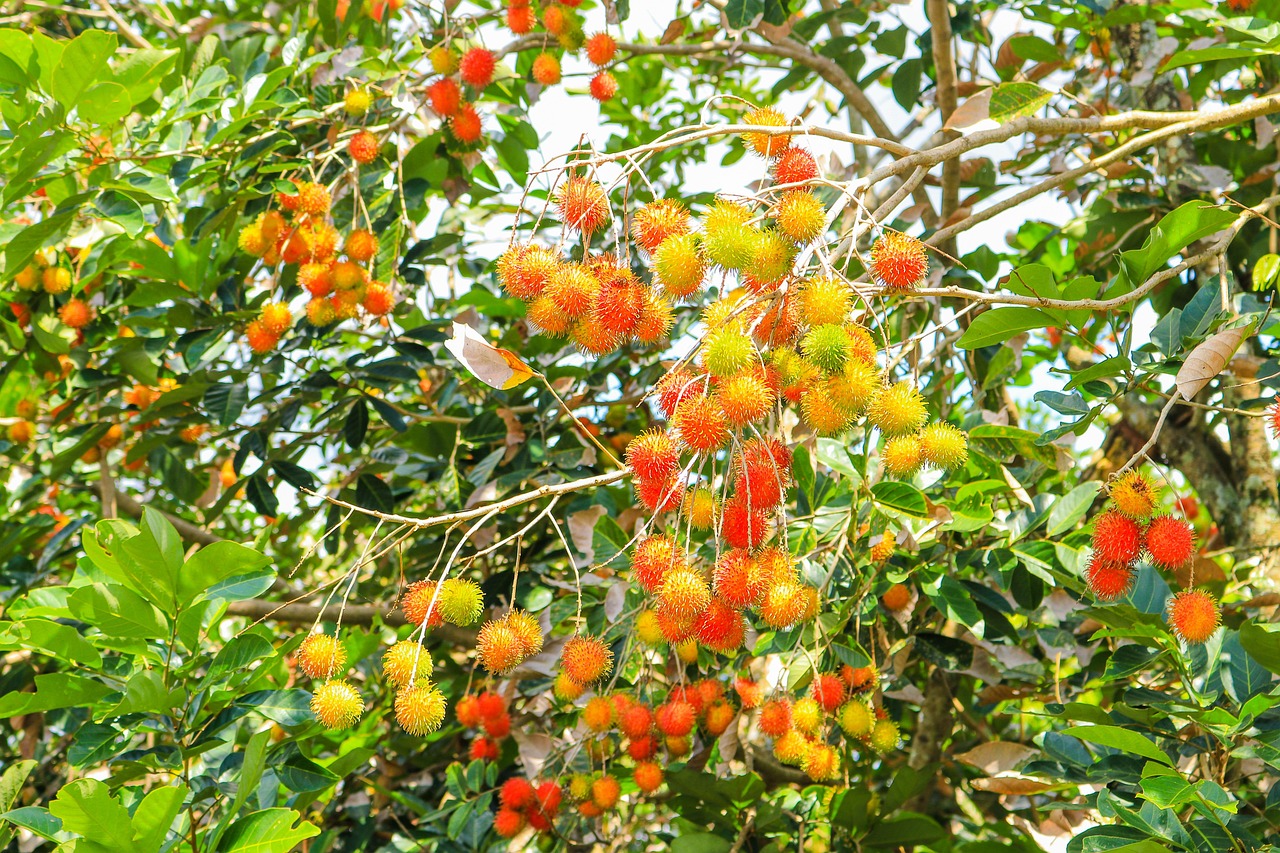The rambutan tree has a moderate growth rate, typically reaching maturity within 5 to 7 years in Southeast Asian orchards. Under optimal conditions, these trees can grow up to 2 meters (approximately 6.5 feet) per year.
Understanding Rambutan Trees
The rambutan tree, known scientifically as Nephelium lappaceum, is native to the tropical regions of Southeast Asia. It is most commonly grown in countries such as Malaysia, Indonesia, Thailand, and the Philippines. The tree is well regarded for its unique, hairy fruit that is both sweet and juicy, making it a favorite among fruit lovers.

In addition to its delicious fruit, the rambutan tree is valued for its ornamental qualities. It features lush, green foliage and can reach heights of 8 to 20 meters (approximately 26 to 66 feet). The tree thrives in warm, humid climates, which are typical of Southeast Asian regions. Understanding its growth rate is essential for farmers and orchard managers aiming to optimize production.
Growth Factors for Rambutan Trees
The growth rate of rambutan trees can be influenced by several environmental and agricultural factors. These include soil quality, water availability, climate conditions, and proper management practices. Below are some key factors that affect the growth rate:
- Soil Quality: Rambutan trees prefer well-draining soils rich in organic matter. Soil pH should ideally be between 5.5 and 6.5.
- Water Availability: Adequate rainfall or irrigation is crucial. Rambutan trees require regular watering, especially during dry periods.
- Climate Conditions: These trees thrive in tropical climates with temperatures ranging from 25°C to 35°C (77°F to 95°F).
- Fertilization: Regular application of fertilizers can enhance growth rates. Balanced fertilizers that provide nitrogen, phosphorus, and potassium are recommended.
- Pest and Disease Management: Effective control of pests and diseases is essential for healthy growth and fruit production.
Growth Rate Timeline
The growth of rambutan trees follows a specific timeline from planting to maturity. Below is a general timeline that illustrates the growth stages:

| Age (Years) | Growth Characteristics | Expected Height (Meters) |
|---|---|---|
| 1 | The tree establishes its root system and begins to grow leaves. | 0.5 – 1 |
| 2 | The tree starts to develop a more significant canopy. | 1 – 2 |
| 3 | Branches begin to spread, and flowering starts. | 2 – 3 |
| 4 | The tree becomes bushy with more flowers and fruits. | 3 – 5 |
| 5 | Maturity is reached; full fruit production begins. | 5 – 8 |
This timeline provides a general overview but can vary based on specific growing conditions and care practices. Farmers often monitor their orchards closely to ensure optimal growth rates.
Rambutan Farming Practices in Southeast Asia
Farmers in Southeast Asia employ various practices to enhance the growth of rambutan trees. These practices not only focus on improving growth rates but also on increasing overall yield. Some common farming practices include:
- Mulching: Applying organic mulch helps retain soil moisture and suppress weeds.
- Pruning: Regular pruning encourages better air circulation and light penetration within the canopy.
- Intercropping: Growing other compatible crops alongside rambutan can improve soil health and reduce pest pressure.
- Pest Control: Integrated pest management (IPM) strategies are adopted to manage potential threats effectively.
By adopting these practices, farmers can significantly influence the growth rate and productivity of rambutan trees in their orchards.

Environmental Conditions Impacting Growth Rates
The growth rate of rambutan trees is significantly influenced by various environmental conditions. Understanding these factors can help farmers in Southeast Asia optimize their orchards for better yields. Here are some critical environmental aspects affecting rambutan tree growth:
Temperature
Rambutan trees thrive in warm tropical climates. Ideal temperatures for their growth range from 25°C to 35°C (77°F to 95°F). Exposure to temperatures below 15°C (59°F) can hinder growth and affect fruit production.
Humidity
High humidity levels, typically between 60% and 80%, are conducive to the healthy growth of rambutan trees. Humidity helps in the effective pollination of flowers and influences fruit set. However, excess moisture can lead to fungal diseases.

Rainfall
Rambutan trees require consistent rainfall throughout the year, ideally between 1,500 mm to 2,500 mm (59 to 98 inches) annually. Adequate water supply is vital, especially during the flowering and fruiting stages. In regions with irregular rainfall, irrigation systems may be necessary to maintain optimal soil moisture.
Soil Type
The choice of soil can dramatically affect the growth rate of rambutan trees. They prefer well-draining sandy loam or loamy soils rich in organic matter. Heavy clay soils can retain too much moisture, leading to root rot and other diseases.
Pest and Disease Management
Rambutan trees are susceptible to various pests and diseases that can impact their growth and yield. Effective management strategies are crucial for maintaining tree health and maximizing production. Below are some common pests and diseases affecting rambutan:
- Pests:
- Fruit Flies: These pests can cause severe damage to fruits, leading to economic losses.
- Leaf Miners: These insects tunnel through leaves, causing them to wither and drop prematurely.
- Scale Insects: These pests suck sap from the leaves and stems, weakening the tree.
- Diseases:
- Root Rot: Caused by overwatering or poor drainage, this disease affects the root system.
- Leaf Spot: Fungal infections that lead to discolored spots on leaves, affecting photosynthesis.
- Anthracnose: A fungal disease that affects fruit quality and yield.
Nutrient Management
Nutrient availability plays a vital role in the growth rate of rambutan trees. Proper fertilization helps ensure that trees receive essential nutrients for healthy development. The key nutrients required include:
- Nitrogen: Promotes leaf growth and overall tree vigor.
- Phosphorus: Essential for root development and flower formation.
- Potassium: Critical for fruit quality and disease resistance.
The application of organic fertilizers such as compost can enhance soil fertility while minimizing environmental impact. Additionally, soil testing can help determine nutrient deficiencies and guide appropriate fertilization practices.
The Role of Pruning in Growth Rate
Pruning is an essential practice that significantly influences the growth rate and fruit production of rambutan trees. Proper pruning techniques can enhance light penetration and air circulation within the canopy. Here are the benefits of pruning:
- Improved Airflow: Reducing excessive foliage allows better airflow, which minimizes the risk of fungal diseases.
- Higher Fruit Quality: Pruning encourages the development of larger, healthier fruits by directing nutrients to fewer branches.
- Easier Harvesting: A well-pruned tree is easier to manage and harvest, reducing labor costs.
The best time to prune rambutan trees is during the dry season when they are not actively growing. This timing minimizes stress on the tree and promotes faster recovery.
Conclusion on Growth Influences
The growth rate of rambutan trees in Southeast Asian orchards is impacted by a multitude of factors including environmental conditions, pest management, nutrient availability, and pruning practices. By understanding these influences, farmers can adopt effective strategies to enhance tree health and productivity.
The Economic Importance of Rambutan Cultivation
Rambutan cultivation plays a significant role in the economy of Southeast Asia. As a tropical fruit, it is not only enjoyed locally but also has a growing demand in international markets. Understanding its economic impact can help farmers and policymakers make informed decisions that benefit both growers and consumers.
Market Demand
In recent years, the demand for rambutan has increased due to its unique flavor and nutritional benefits. This fruit is often featured in fruit salads, desserts, and juices. The following factors contribute to its market demand:
- Health Benefits: Rambutan is rich in vitamins, minerals, and antioxidants, making it a popular choice for health-conscious consumers.
- Export Opportunities: Countries like Malaysia and Thailand export rambutan to markets in Europe, the United States, and the Middle East.
- Culinary Versatility: The fruit is used in various cuisines, enhancing its appeal across different cultures.
Economic Contributions
The cultivation of rambutan trees contributes to local economies in several ways:
- Job Creation: Orchards provide employment opportunities for local communities in farming, harvesting, and processing.
- Income Generation: Successful rambutan production can significantly boost farmers’ incomes, leading to improved livelihoods.
- Support for Related Industries: The fruit industry supports other sectors, such as transportation, packaging, and retail.
Best Practices for Maximizing Growth Rates
To enhance the growth rate and productivity of rambutan trees, farmers can implement various best practices. These methods encompass agricultural techniques, management strategies, and innovative technologies.
Soil Management
Healthy soil is fundamental to robust growth. Farmers should focus on the following soil management practices:
- Regular Soil Testing: Conducting soil tests helps identify nutrient levels and pH balance, allowing for informed fertilization decisions.
- Addition of Organic Matter: Incorporating compost or well-rotted manure improves soil structure and provides essential nutrients.
- Crop Rotation: Rotating crops helps maintain soil health and prevent nutrient depletion.
Irrigation Techniques
Irrigation plays a crucial role in maintaining consistent moisture levels. Effective irrigation techniques include:
- Drip Irrigation: This method delivers water directly to the root zone, minimizing waste and ensuring adequate moisture.
- Rainwater Harvesting: Collecting rainwater can supplement irrigation needs during dry spells and reduce water costs.
Integrated Pest Management (IPM)
Implementing an IPM strategy is essential for controlling pests while minimizing chemical use. Key components include:
- Monitoring Pest Populations: Regularly checking for pests allows for timely interventions before infestations occur.
- Biological Control: Utilizing natural predators helps keep pest populations in check without harming the environment.
- Cultural Practices: Adjusting planting dates and crop spacing can reduce pest pressure and promote healthier trees.
Nutritional Value of Rambutan
The rambutan fruit is not only delicious but also packed with essential nutrients. Its nutritional profile makes it a valuable addition to a healthy diet. Below is a summary of its key nutritional components per 100 grams of fresh rambutan:
| Nutrient | Amount (per 100g) |
|---|---|
| Calories | 68 |
| Carbohydrates | 16 g |
| Sugars | 9 g |
| Fiber | 0.9 g |
| Protein | 0.9 g |
| Fat | 0.2 g |
| Vitamin C | 20 mg (34% DV) |
| Calcium | 22 mg (2% DV) |
| Iron | 0.3 mg (2% DV) |
This nutritious profile highlights the potential health benefits of including rambutan in one’s diet, further driving its popularity among consumers.
Cultural Significance of Rambutan
The rambutan fruit holds cultural importance in many Southeast Asian countries. It is often featured in festivals, celebrations, and traditional dishes. Here are some aspects of its cultural significance:
- Culinary Traditions: Rambutan is used in various traditional recipes, from salads to desserts, showcasing its versatility.
- Cultural Festivals: Some regions celebrate rambutan harvests with festivals that include music, dancing, and food stalls highlighting local produce.
- Cultural Symbolism: In certain communities, rambutan represents prosperity and abundance, making it a favored gift during special occasions.
The cultural ties to rambutan enhance its value beyond just an agricultural product, reinforcing its importance in the social fabric of the region.
Challenges Facing Rambutan Cultivation
While rambutan cultivation presents numerous benefits, it is not without its challenges. Farmers in Southeast Asia face various obstacles that can hinder growth rates and overall productivity. Understanding these challenges is crucial for developing effective strategies to overcome them.
Climate Change
Climate change poses a significant threat to the stability of rambutan orchards. Variations in temperature, rainfall patterns, and extreme weather events can adversely affect growth and fruit production. Farmers may need to adapt their practices to cope with these changes, such as:
- Adopting Resilient Varieties: Developing or selecting varieties that can withstand extreme weather conditions may become essential.
- Enhancing Water Management: Implementing efficient irrigation systems can help mitigate the impact of irregular rainfall.
Pest Resistance
As pests evolve, they can become resistant to conventional control methods. This resistance can lead to increased crop damage. Farmers must stay informed about pest management practices, including:
- Regular Monitoring: Keeping an eye on pest populations ensures timely interventions.
- Innovative Solutions: Research into biological pest control methods can offer sustainable alternatives to chemical treatments.
Market Fluctuations
The market for rambutan can be volatile, influenced by factors such as supply and demand dynamics, international trade policies, and competition from other fruits. To thrive in this environment, farmers should consider:
- Diversification: Growing multiple crops can reduce financial risk and provide alternative income sources.
- Establishing Cooperative Marketing: Collaborating with other farmers to market their produce collectively can improve bargaining power and market presence.
Future Prospects of Rambutan Cultivation
The future of rambutan cultivation in Southeast Asia looks promising if farmers adopt innovative practices and address current challenges effectively. Continued research and investment in technological advancements will be crucial for enhancing growth rates and improving overall orchard management.
Sustainability Practices
Sustainable practices are becoming increasingly important in agriculture. For rambutan growers, integrating sustainability into their farming techniques can lead to long-term viability. Sustainable practices may include:
- Organic Farming: Reducing chemical inputs can benefit the environment and enhance soil health.
- Agroforestry: Combining rambutan cultivation with other tree species can improve biodiversity and create a more resilient ecosystem.
Technological Innovations
The advent of technology in agriculture provides new opportunities for enhancing rambutan production. Some promising technologies include:
- Drones: Utilizing drones for monitoring crop health can help farmers identify issues early and make informed decisions.
- Soil Sensors: These devices measure moisture levels in real-time, allowing for precise irrigation management and reducing water waste.
Conclusion
The growth rate of rambutan trees in Southeast Asian orchards is influenced by multiple factors, including environmental conditions, agricultural practices, and market dynamics. By understanding the challenges and opportunities presented by rambutan cultivation, farmers can implement strategies that promote sustainable growth and profitability.
As the demand for rambutan continues to rise globally, it is critical for growers to adapt to changing circumstances. Embracing innovative practices, focusing on sustainability, and engaging in cooperative marketing can pave the way for a thriving future in rambutan cultivation. Ultimately, the combination of effective management practices and a strong market presence will determine the success of rambutan orchards in the years to come.
